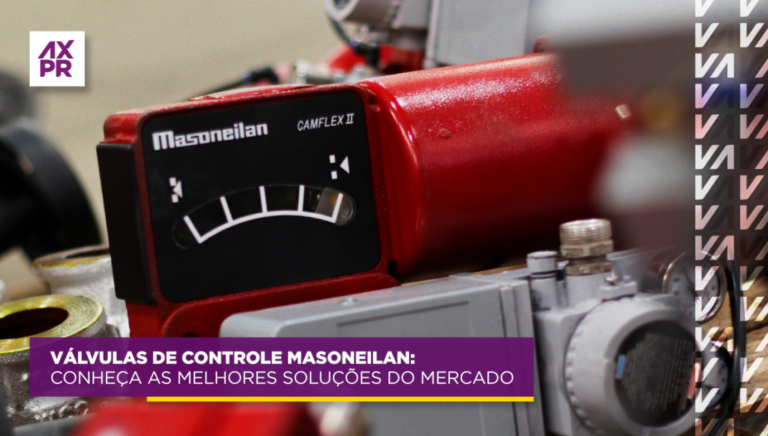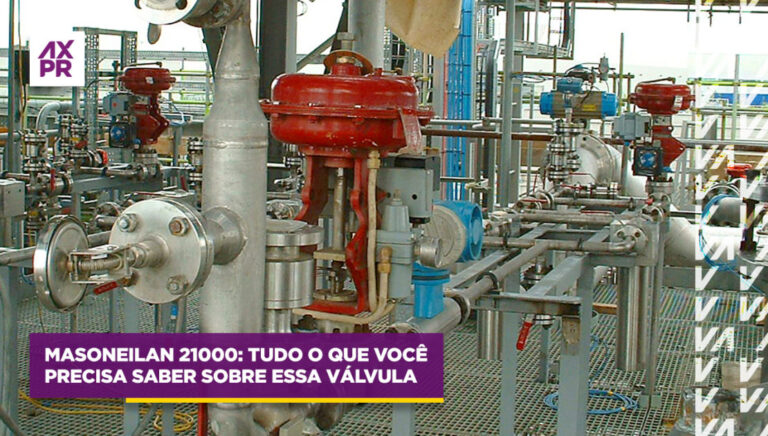Learn about the role of this instrument in control valves and all its advantages.
Operating in conjunction with the actuator of a control valve, the positioner is a device that ensures much more precision and management in its operation. In this way, this instrument becomes essential if your goal is to automate your process.
Thinking of providing more information on the subject, we will address the following topics in this article:
- What is a positioner and its function;
- Different energy sources;
- Analog positioner vs. digital positioner;
- Models from the Masoneilan portfolio;
- Advantages of a positioner.
At the end of this article, we will also give you an essential tip that will help you obtain the reading of the data provided by digital positioners in a simple and objective way.
Ready for more content? Let's dive in!
What is a Positioner and Its Function
The positioner is nothing more than an accessory that is attached to a control valve to transmit a pressure determined by the control system in order to correctly position the shutter.
Its primary function is to provide pressurized air to the valve actuator so that the position of the valve stem or shaft exactly matches the point indicated by the controller. This positioning, in turn, varies according to the operational needs.
Thus, a positioner controls the airflow into the actuator chambers until the desired position is reached by the actuator, keeping it regulated and also allowing for improved performance of a control valve and greater precision in production processes.
Additionally, we can also say that another fundamental function is to maintain a balance between the signal transmitted by the controller and the exact position of the shutter.
That is, its operation is directly related to the actuator since the controller signal passes through the positioner before going directly to it. We recommend reading a very interesting article that has just been published on our blog about actuators for you to learn more about the subject. Click here and check it out!
Advantages of a Positioner
Able to serve various industry segments, positioners have several advantages. Among them, we can mention:
- Valve automation for remote control;
- Cost reduction with staff;
- Process precision, as it prevents line and production loss (fluid control);
- Reduction of variations in the process;
- Calibration, command, and configuration of the positioner in the control room;
- Safety in registering how the valve operated;
- Prevents human error;
- Quick response in case of process changes;
- Reduces the effects of friction on the control valve stem sealing.
Next, let's get to know the various energy sources that power this instrument.
Different Energy Sources for Positioners
To perform the function of automating the industrial process, positioners need an energy source provided by a signal (pneumatic, electric, or digital), and that's what we'll see next.
Pneumatic Positioner
This type of positioner receives pneumatic signals (compressed air) to provide the correct air pressure to move the valve shutter to the desired position. Among its characteristics, we can mention that they are extremely safe and, when necessary, can provide a large amount of force to close the valve.
Electropneumatic Positioner
It performs the same function as pneumatic positioners but converts electricity and air to control the valve shutter. Among its advantages, we can mention that they have a higher level of control than other types of positioners.
Digital Positioner
In turn, digital positioners function just like electropneumatic ones, but instead of obtaining an analog signal , they receive a digital signal. In addition, they embed much more technology capable of recording data and monitoring the valve.
Next, let's understand in more detail the difference between an analog and digital positioner.
Analog Positioner vs. Digital Positioner
Certainly, after reading the previous topic, some doubts arose in your mind: Which positioner is better: analog or digital? How to understand which one is ideal for my operation? What is the main difference between them? Let's clarify all of this now!
Check out the table below with more details on these differences.
| Analog Positioner | Digital Positioner |
| The signal can be pneumatic or electric. | The signal is digital (in bits). |
| Simple construction with mechanical adjustments. | Construction with circuit boards and a microprocessor. |
| Offers feedback if the command was executed correctly. | Offers feedback and stores data to create reports. |
As seen, among the differences that exist between these positioners, the main one is related to their construction. While analog positioners have a mechanical structure, digital positioners have circuit boards that offer digital signals.
Also, although both offer feedback if the valve responded to the controller signal, that is, if the shutter moved to the desired position, digital positioners have a microprocessor capable of storing data that can be processed by a specialist later.
Thus, these data can be very beneficial when it comes to improving your process. Next, let's clarify a very common question when it comes to electric valves and positioners.
Comparison Between Positioner and Electric Valve
In the industrial sector, a recurring question arises regarding a comparison between the positioner and the electric valve: which one is more worthwhile?
The electric valve is a device that does not require a positioner; its activation is direct, while for other control valves, if the desire is to obtain process automation, it is essential to have a positioner.
Therefore, it is common to have this question regarding the cost-benefit of both solutions. The answer to this will also depend a lot on the operation's needs and available resources, but summarily, the electric valve, although much more precise, has a higher cost and is slower.
Now, let's get to know the models in the Masoneilan portfolio Masoneilan, a brand that has been transforming the global valve market for over 100 years.
Masoneilan Positioner: Get to Know the Best Models
Renowned for their accuracy in processes and robustness, the positioners in the Masoneilan catalog have several characteristics that allow them to serve various industrial segments.
Let's start by mentioning the analog positioners: the 4700P (pneumatic) and 4700 E (electric). These models are recognized in the market for providing precise positioning, rapid response, and easy maintenance.
In addition, the internal components are manufactured with corrosion-resistant materials to protect against the most severe environments, being a differential across the sector.
Now talking about digital positioners, we can mention the SVi line, which is composed of 3 generations:
SVI 1000: It is a positioner that supports HART communications over the 4-20mA signal. Among the main benefits are:
- Reliable and precise valve positioning;
- Local or remote configuration;
- Integration with many control and management systems;
- Components that allow feedback on the valve.
SVI II: It has a 32-bit microprocessor with a local interface that controls the pneumatic actuator using a two-wire 4-20mA signal. When it comes to its advantages, we can mention:
- Universal design that offers retrofit ease;
- Contactless position detection technology;
- Quick and precise commissioning with automatic stops and adjustment methods;
- Adaptability to various applications (rotary or linear) and (remote or local);
- Simple assembly procedure.
SVI3: This is the most innovative model in the line. It uses advanced control and diagnostic algorithms, as well as contactless position detection technology to offer precise, responsive, and reliable positioning performance.
It also ensures:
- Plant efficiency through online valve diagnostic features and data storage;
- Simplified commissioning and optimized user interfaces;
- Enhanced pneumatic performance, as it reduces 40% in steady-state air consumption, with a 15% increase in air supply;
- Simple and fail-safe action.
In addition to all these benefits, SVI line positioners have various certifications, including ATEX, IECEx, USA, and Canada , which prove that the products are fireproof, explosion-proof, and dust ignition-proof.
Next, let's get to know the software capable of further enhancing your experience with SVI3 digital positioners.
SVI3 Advanced DTM Software
The SVI3 Advanced DTM is a user-friendly graphical interface that allows efficient configuration of an SVI3 positioner mounted on any control valve assembly. Its functionalities include:
- Configuration wizard;
- Remote display of valve position;
- Allows setting calibration and configuration parameters;
- Monitors status and error indicators;
- Offers valve position adjustment;
- Backup and restore configuration;
- Performs test and diagnostic procedures;
- Displays comparative test results;
- Monitors valve integrity;
- Has data management options.
Note: This software is available for free trial, but you can purchase it according to the plans offered by Masoneilan. Want to know more about this? Then don't waste time and chat now with our team by clicking here!
These are various resources that allow data management and analysis, and if at this moment you do not have specialized professionals in your team to extract the most from this technology, know that we can help!
Extracting Data to Enhance Your Process
In addition to being an authorized representative, distributor, and service center for Masoneilan in Brazil,we offer data analysis and management services provided by positioners.
This means that you will be able to enjoy even more of all the resources allowed by Masoneilan positioners with the help of our specialists.
They will extract all the information provided, interpret it, and provide you with a simple and objective report on the analysis, allowing you to make the best decisions to further improve your process.
Whether it's supplying a quality positioner or reading this data, count on us to help you with this ! Just click here and chat now with our team!




